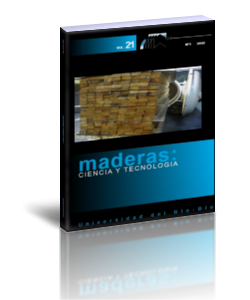Effect of adhesive quantity on selected physico-mechanical properties of bamboo glulam
Keywords:
Bambusa vulgaris, compressive strength, density, glue application rate, optimal glue quantityAbstract
This study was aimed at determining the optimal glue quantity for bamboo lamination. Bamboo laminated boards were produced using glue applied at three different rates: 150 g/m2, 200 g/m2 and 250 g/m2. The boards produced were evaluated for their physical (density, longitudinal, tangential, radial and volumetric shrinkage) and mechanical (impact bending strength, modulus of elasticity, modulus of rupture and maximum compressive strength parallel to grain properties. It was discovered that the boards were uniform in their investigated physical properties but the glue quantity significantly influenced both the impact bending strength and modulus of rupture of the boards. Based on the results, it was observed that the boards produced with glue applied at the rate of 200 g/m2 met all the technical specifications on the basis of the investigated physical and mechanical properties, hence, concluded to be the optimal glue quantity for bamboo lamination.
Downloads
References
Anokye, R.; Kalong, R.M.; Bakar, E.S.; Ratnansingnam, J.; Jawaid, M.; Awang, K. 2014. Variations in moisture content affect the shrinkage of Gigantochloa scortechinii and Bambusa vulgaris at different heights of the bamboo culm. Bioresources9(4): 7484-7493.
Anokye, R.; Bakar, E.S.; Ratnansingnam, J.; Awang, K.B. 2016. Bamboo Properties and Suitability as a Replacement for Wood. Pertanika Journal of Scholarly Research Reviews 2(1): 63-79.
Anwar, U.M.K.; Hiziroglu, S.; Hamdan, H.; Abd. Latif, M. 2011. Effect of outdoor exposure on some properties of resin-treated plybamboo. Industrial Crops and Products 33 (1): 140-145.
Anwar, U.M.K.; Paridah, M.T.; Hamdan, H.; Sapuan, S.M.; Bakar, E.S. 2009. Effect of curing time on physical and mechanical properties of phenolic-treated bamboo strips. Industrial Crops and Products 29(1): 214-219.
ASTM Standard International. 2006. Evaluating the properties of wood-based fiber and particleboard material ASTM D-1037-06. 2006
Chaowana, P. 2013. Bamboo: An alternative raw material for wood and wood-based composites. Journal of Materials Science Research 2(2): 90-102.
Chaowana, P.; Jindawong, K.; Sungkaew, S. 2015. Adhesion and Bonding Performance of Laminated Bamboo Lumber made from Dendrocalamus sericeus. In: Product Design and Technology. The 10th World Bamboo Congress held in Korea, 2015
Desch, H.E.; Dinwoodie, J.M. 1981. Timber: its structure, properties and utilisation. 6th Edition, Macmillian Education Ltd : London.
Dinwoodie. J.M. 1989. Wood: Nature's cellular, polymeric fibre-composite. The Institute of Metals : London.
Erakhrumen, A.A.; Ogunsanwo, O.Y. 2009. Water absorption, anti-swell efficiency, and dimensional stability properties of neem seed oil treated wild grown Bambusa vulgaris Schrad. Ex J.C. Wendl. in Southwest Nigeria. BioResources4(4): 1417-1429.
Gutu, T. 2013. A study on the mechanical strength of bamboo to enhance its diversification on its utilization. International Journal of Innovative Technology and Exploring Engineering 2(5): 314-319.
Jassen, J.J.A. 1995. Building with bamboo. 2nd edition, Intermediate Technology Publication Limited : London.
Li, X. 2004. Physical, chemical and mechanical properties of bamboo and its utilization potential for fibreboard manufacturing. M.Sc. Thesis, Louisiana State University, Baton Rouge, LA, USA.
Liese, W. 1985. Bamboos-biology, silvics, properties, utilization. Deutsche Gesellschaft fürTechnische Zusammenarbeit (GTZ) GmbH : Eschborn, Germany.
Mahdavi, M.; Clouston, P.L.; ASCE, A.M.; Arwade. S.R. 2011. Development of Laminated Bamboo Lumber: Review of Processing, Performance and Economical Considerations. Journal of Materials in Civil Engineering 23(7): 1036-1042
Malanit, P.; Barbu, M.C.; Frühwald, A. 2009. The gluability and bonding quality of an Asian bamboo Dendrocalamus asper for the production of composite lumber. J Trop Forest Sci 21(4): 361-368.
Malanit, P.; Barbu, M.C.; Liese, W.; Frühwald, A. 2008. Macroscopic aspects and physical properties of Dendrocalamus asper Backer. for composite panels. Journal of Bamboo and Rattan 7(3&4): 151-163.
Ogunsanwo, O.Y.; Omole, A.O. 2010. Basic Practical Procedures in wood science. In Ijeomah, H. M. and Aiyeloja, A.A (Eds). Practical Issues in Forest and Wildlife Resources Management.
Ogunsanwo, O.Y.; Terziev, N. 2010. Mechanical Properties of Glue-Laminated Boards of Bamboo Bambusa vulgaris from Nigeria. Kidela, J and Lagana, R (Eds) Proceedings of 6th International Symposium on Wood Structure and Properties. Zvolen, Slovakia, September, 6 - 10, 2010. . Pp 183-186.
Ogunsanwo, O.Y.; Terziev, N.; Panov, D.; Daniel, G. 2015. Bamboo (Bambusa vulgaris Schrad.) from Moist Forest and Derived Savanna Locations in South West Nigeria-Properties and Gluability. ‘Nigerian bamboo’ BioResources 10(2): 2823-2835.
Yu, H.Q.; Jiang, Z.H.; Hse, C.Y.; Shupe, T. 2008. Selected physical and mechanical properties of Moso bamboo (Phyllostachys pubescens). J Trop Forest Sci 20(4): 258-263.

































